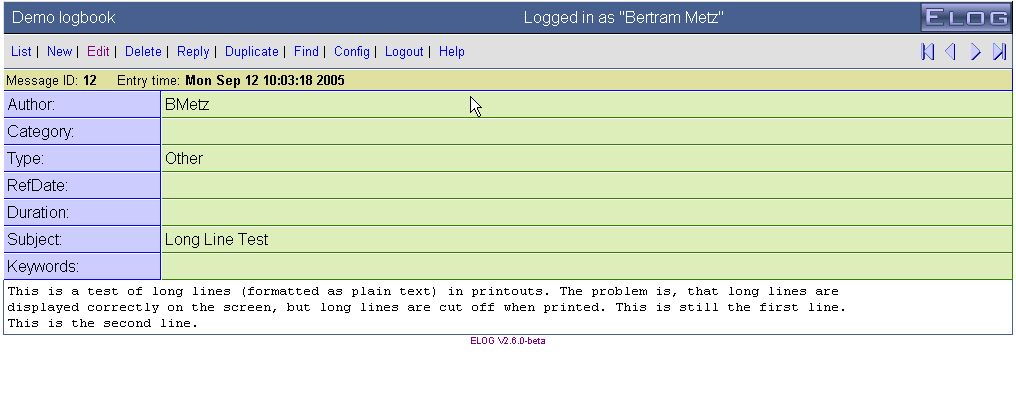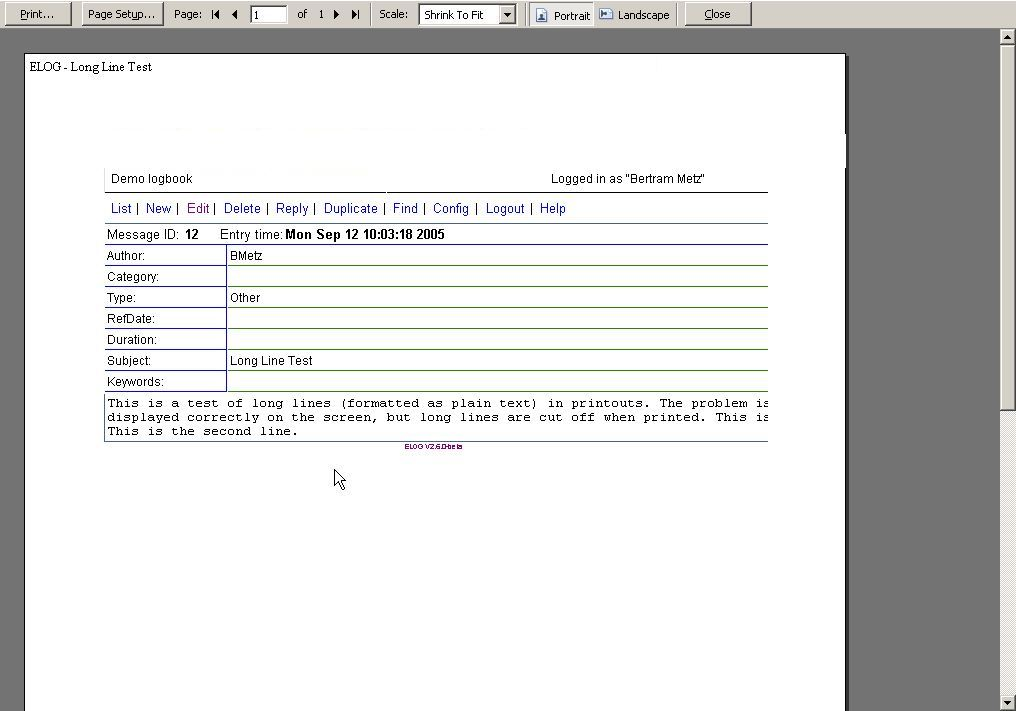| ID |
Date |
Icon |
Author |
Author Email |
Category |
OS |
ELOG Version |
Subject |
|
66992
|
Wed Jan 19 16:19:56 2011 |
 | bob | bobgrang@gmail.com | Question | Windows | V2.8. | Re: Modification aren't accepted |
| Stefan Ritt wrote: |
|
| bob wrote: |
|
hello,
At home, when I change the config *. cfg, the modifications are not taken in consideration
Have you got a idea ?
Thanks a lot ! 
Bob
|
Not really, you are the first one reporting this issue. Just some thoughts:
- Can you see the changes if you look at elogd.cfg with a text editor such as notepad?
- Some write protection of elogd.cfg
- Do you have more than one server running at the same time and changing the wrong one's config?
- Stefan
|
>- Can you see the changes if you look at elogd.cfg with a text editor such as notepad?
I change the configuration directly on elogd.cfg, (after i save and update my web page, and i not modification immediately)
>- Some write protection of elogd.cfg
no
- Do you have more than one server running at the same time and changing the wrong one's config?
i have one server with elog |
|
66996
|
Thu Jan 20 13:49:22 2011 |
 | bob | bobgrang@gmail.com | Question | Windows | V2.8. | Re: Modification aren't accepted |
| Stefan Ritt wrote: |
|
| David Pilgram wrote: |
|
Let me report when I see this behaviour.
If I use a text editor on elog.cfg directly, while elog is running, then when I save the file, the new elog.cfg is in place,
but the running elog is still running with the old configuration. You have to restart elog for it to read the new config file and
use the new settings.
This does not apply if you edit elog.cfg via the "config" option in the menu command, where elog will read the new elog.cfg
just after it has been saved.
The reason I sometimes edit the file directly is if I want to create a new logbook, but with all the configuration of another logbook,
and it's quickest to cut-and-paste, change the heading, create a new directory and restart elog.
This may be completely off what is being reported.
|
Minor changes you do externally to the elogd.cfg file are reflected immediately under Windows (under Linux you have to send a HUP signal to the process to re-read the configuration). But if you make major changes like adding a new logbook, you have to restart elogd.
|
Yes, exactly!
I prefer to use the elog.cfg for change my config.
But, How do you do for restar the elogd ? with Unregister ELOG server service ?
Anyway, thanks for yours answers !
Bob
|
|
523
|
Thu Apr 8 15:05:43 2004 |
 | Bertram Metz | bmetz@sbs.com | Question | Windows | 2.5.2 | Global password file together with guest account |
Hello,
is it possible to have an guest account together with a global password file?
I tried to put the password file statement into the global section of
elogd.cfg. But in this case every user must login and it is not possible to
have a read only guest account.
But if I put the password file statemnet into the logbook sections, it is
possible to access the logbooks in read-only mode without logging in. The
drawback of this solution is, that you have to login into every logbook
seperately.
Bertram |
| Attachment 1: elogd.cfg
|
[global]
Port = 8080
Logfile = elogd.log
Logging level = 3
Self register = 1
Logout to main = 1
Logbook tabs = 1
Password file = ./passwd
Admin user = BMetz
Guest menu commands = Back, Find, Login, Help
Guest find menu commands = Find, Select, Login, Help
[CP9]
;Password file = ./passwd
Theme = default
[CR9]
;Password file = ./passwd
Theme = default
|
|
525
|
Thu Apr 8 15:42:52 2004 |
 | Bertram Metz | bmetz@sbs.com | Question | Windows | 2.5.2 | Re: Global password file together with guest account |
> > Hello,
> >
> > is it possible to have an guest account together with a global password file?
> >
> > I tried to put the password file statement into the global section of
> > elogd.cfg. But in this case every user must login and it is not possible to
> > have a read only guest account.
> > But if I put the password file statemnet into the logbook sections, it is
> > possible to access the logbooks in read-only mode without logging in. The
> > drawback of this solution is, that you have to login into every logbook
> > seperately.
> >
> > Bertram
>
> Right, guest access is not possible with a global password file. This comes from
> the fact that people wish to protect their logbook selection page. What I can do
> is add another flag "protect selection page = 0 | 1". If "0", the logbook
> selection page can be seen without logging in. Is that what yo want?
>
> - Stefan
Yes, that is what I want.
Bertram |
|
527
|
Tue Apr 13 11:13:53 2004 |
 | Bertram Metz | bmetz@sbs.com | Question | Windows | 2.5.2 | Re: Global password file together with guest account |
> > Yes, that is what I want.
>
> I implemented a switch "protect selection page" in revision 1.318, which can be
> obtained at http://midas.psi.ch/cgi-bin/cvsweb/elog/src/elogd.c?rev=1.318. If this
> switch is not set to "1", the selection page can be seen without having to log in.
Stefan,
thank you for the fast implementation of this feature. I compiled the new revision and
it worked as expected.
Kind regards,
Bertram |
|
1395
|
Wed Aug 10 10:50:55 2005 |
 | Bertram Metz | bmetz@sbs.com | Question | Linux | 2.6.0-beta | Long lines in printout |
Hi,
long lines in an entry are not printed correctly (the lines are cut off), if the text is encoded as plain text. This works correctly, if the text is encoded as ELCode. I tried this with Firefox and Internet Explorer. Does anybody know a solution for this?
Thanks,
Bertram |
|
1413
|
Mon Sep 12 10:44:51 2005 |
 | Bertram Metz | bmetz@sbs.com | Question | Linux | 2.6.0-beta | Re: Long lines in printout |
> > long lines in an entry are not printed correctly (the lines are cut off), if the text is encoded as plain
> > text. This works correctly, if the text is encoded as ELCode. I tried this with Firefox and Internet Explorer.
> > Does anybody know a solution for this?
>
> Can you post an example here? If I try a
>
veeeeeeeeeeeeeeeeeeeeeeeeeeeeeeeeeeeeeeeeeeeeeeeeeeeeeeeeeeeeeeeeeeeeeeeeeeeeeeeeeeeeeeeeeeeeeeeeeeeeeeeeeeeeeeeeeeeeeeeeeeeeeeeeeeeeeeeeeeeeeeeeeeeeeeeeeeeeeeeeeeeeeeeeeeeeeeeeeeeeeeeeeeeeeeeeeeeeery
> long line, it's shown correctly. You just have to scroll right in your browser.
the lines are displayed as expected on the screen, but they are cut off when the browser window is printed via
the browsers print function.
This did not occur in a previous version (V2.5.6).
Bertram |
| Attachment 1: elog_lon_lines_screen.jpg
|

|
| Attachment 2: elog_lon_lines_print.jpg
|

|
|
1451
|
Thu Oct 13 10:56:29 2005 |
 | Bertram Metz | bmetz@sbs.com | Question | Linux | 2.6.0-beta | Re: Long lines in printout |
Hi Stefan,
I tried your suggestions with 'page shrinking' and 'message width', but they didn't help. What I do not understand is why this problem occurs only if the message text is formatted as plain text. The lines are printed correctly, if the text is formatted as EL code or as HTML.
It is of course possible to format new entries in EL code or HTML, but we have a lot of existing entries, which are formatted as plain text.
Kind regards,
Bertram |